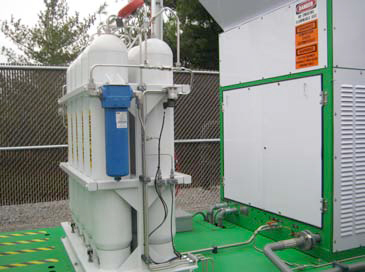A Greener Future For The Garden State? The Role of Natural Gas Vehicles (continued)
- Natural gas vehicles generate 20 to 30% fewer greenhouse gas emissions compared to diesel.
- Natural gas vehicles are fully commercial choices and operate both cleanly and quietly! More than 16,000 CNG trucks and buses travel US roads today[xxii].
- Natural gas vehicles are also the best investment. Federal tax incentives cover up to 80% of their higher costs plus up to 50% of the costs of new refueling stations. Incentives also make the fuel itself $1 to $1.50 cheaper per gallon than diesel, giving a CNG refuse truck $10,000 or more in annual fuel cost savings.
- Producing this domestic fuel, the vehicles that use it and the refueling stations and maintenance services for them creates new "green" jobs.
STEPS FORWARD FOR THE GARDEN STATE
Up to 2009, there was a small number of NJ Transit buses and utility vehicles plus two truck fleets used CNG, and there were just 23 CNG refueling stations – none publicly accessible.

Map of Natural Gas Filling Stations in NJ
In 2009, EarthTech Contracting purchased the first CNG refuse fleet for Ocean View, New Jerseyxxiii. Then, Central Jersey Waste (CJW) won the contract for hauling Hamilton Township’s waste, which required the use of natural gas refuse trucks. Clean Energy, a California-based company and largest provider of natural gas for transportation in the US, opened a station for CJW in the fall of 2009 (capable of fueling 30 trucks)[xxiv]. Following their lead, Newark, Camden, and Atlantic City have gotten in on the act, and have helped usher in the new age of natural gas for New Jersey
$14.9 million in stimulus funding by the Obama Administration jumpstarted fleet conversions and infrastructure expansion in the State[xxv]. Largely with these funds, leveraging $38.7 million from private sector investment, NJ will soon have 289 CNG trucks and buses on its roadways, and 5 new refueling stations. This will displace 1,891,900 gallons of diesel fuel per year.
289 CNG Refuse Trucks and Buses and 5 Refueling Stations, Supported Largely by Federal Stimulus Funds
| Initiative | CNG Vehicles | Diesel Fuel Displaced | New CNG stations |
| Hamilton Township, CJW | 42 trucks | 499,200 gals | 1 |
| Newark | 25 trucks | 130,000 gals | 1 |
| ACUA | 15 trucks | 137,700 gals | 1 |
| Atlantic City Jitney | 190 buses | 969,000 gals | 1 |
| Camden, Waste Management | 17 trucks | 156,000 gals | 1 |
| Total | 289 | 1,891,900 gals | 5 |
SO WHAT’S NEXT FOR NEW JERSEY?
Much has been done to improve the air quality in New Jersey, but the opportunity to embrace natural gas for fleets in the State brings with it environmental, energy security, and economic gains for the State.
In addition, perhaps the greatest long-term benefit is the role that natural gas use plays as a stepping-stone toward use of another even better gas fuel, called "biomethane." Biomethane is, in fact, natural gas (CH4), but a form that is obtained not by drilling but by using the biogases that are generated wherever organic wastes are breaking down: in landfills or in sewage treatment plants, in dairy or agricultural operations.
Collecting and refining these gases turns our expensive garbage problem into a renewable fuel solution! Also, it is a carbon-free solution, since making biomethane captures more methane (a powerful greenhouse gas) than the vehicles using it create. Biomethane is being widely used in Europe already in vehicles, and as production in the US grows, fleets using traditional natural gas today can make a "seamless" transition to this first truly sustainable fuel[xxvi].

CNG storage bottles at the refueling station built and operated by Clean Energy for Central Jersey Waste’s refuse trucks
How public leadership can help: The State’s Diesel Retrofit Law of 2005 has ensured some progress in addressing diesel vehicle pollution by installing diesel particle filters on older fleets. But the efforts to use end-of-the-pipe technology to meet the EPA’s 2010 standards require new diesel trucks to use more sophisticated technologies that are proving much more complex and expensive[xxvii].